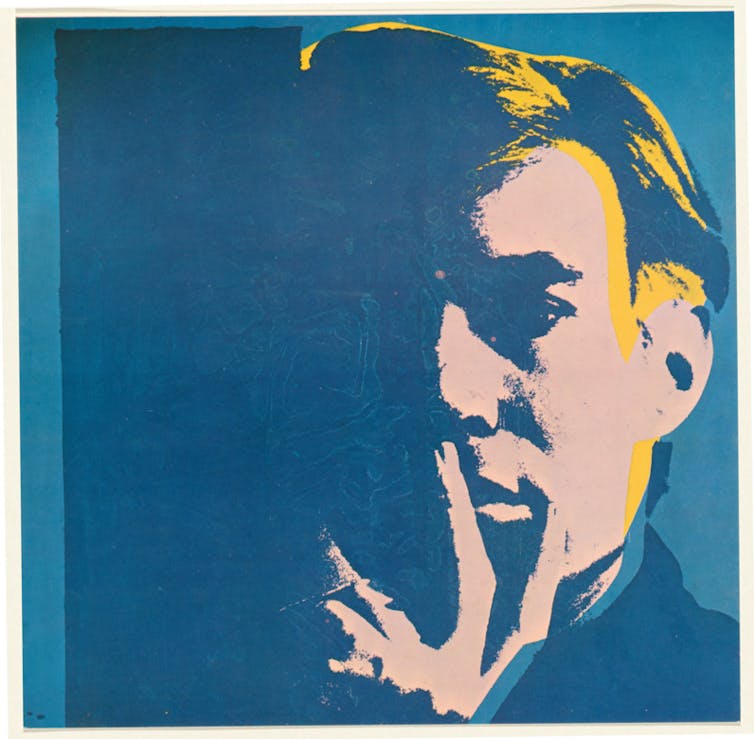It is unexpected and oddly refreshing to see Andy Warhol in a regional Australian art gallery
- Written by Christina Chau, Lecturer at Curtin University, Curtin University

Until 2026, Wanneroo Regional Art Gallery will be showing 53 original artworks by one of the most famous artists of the 20th century: Andy Warhol. Andy Warhol ICONS includes famous works such as Elvis (1963), Campbell’s Soup Cans (1968) and Marilyn (1967).
When thinking about international pop art, it’s hard to think of someone more famous than Warhol. He is remembered as the embodiment of American pop – making iconic portraits of key celebrities, many as memorable as the people themselves.
The artworks have become celebrities in their own right. In 2022 Warhol’s Shot Sage Blue Marilyn sold for US$195 million in under four minutes of bidding at Christie’s, making it the most expensive 20th century artwork to sell at an auction.
Considering the historical and international notoriety of his artworks, it is surprising how little publicity there has been about this exhibition.
Consequently, Andy Warhol ICONS is likely to attract audiences local to the commercial centre of Wanneroo, or die hard art history fans from Perth willing to trek along the Kwinana Freeway.
To see Warhol’s original works here in the northern suburb of Perth gives off a very different aura to other art meccas across the world where Warhol’s works have been collected and shown in. Instead of the Tate London or MoMA in New York City, this gallery is in the middle of Wanneroo’s cultural precinct and commercial centre.
It is unexpected and oddly refreshing to see such famous works in a regional gallery. Perhaps this match between regional hub and high art is much more apt. Warhol is notorious for his ambivalent approach to advertising and consumer goods that boomed after the second world war.
Like many other American avant-garde artists, Warhol was interested in collapsing distinctions between art and the everyday. In this exhibition we see first hand that he called himself a “commercial artist”. He turned wooden crates into Brillo Boxes, made collages from celebrity magazines, and transformed a gallery into a faux supermarket.
Critics were never entirely sure if he was endorsing or hypercritical of capitalist consumer culture.
Read more: Andy Warhol’s Marilyn Monroe portraits expose the darker side of the 60s
Up close with Warhol
A captivating piece in the exhibition is the video documentary by WNET of Warhol up close. Here we see first hand how Warhol dances between commercial artist and reticent art provocateur when he dodges answering questions. “Why don’t you just tell me the words and they’ll just come out of my mouth,” he tells the filmmaker while yawning – feigning to not understand the questions.
We are under no illusion about this entertaining performance.
Together with his self portrait (1970), a highly contrasted blue and yellow photo lithograph where half of Warhol’s face is obscured by his shadow, the exhibition continues the performance of Warhol as an aloof, enigmatic character.
Seeing these artworks in Wanneroo continues Warhol’s contradictory play on viewers’ expectations around high art, capitalism, pop culture and the everyday. The exhibition plays with themes of repetition, authenticity and pop culture in a suite of Campbell’s Soup Cans (1968), repetitive prints of Mona Lisa (1970) and Elvis (1963).
While some viewers may have seen Warhol artworks in the flesh, many might be more familiar with these pieces online. This exhibition gives the opportunity to get up close and take time with some of Warhol’s key lithograph prints. Each is grainier, more delicate with edges less crisp and saturated than their online copies.
With Cow (1966), the newsprint pixels are more than a slick nod to newsprint. Instead we can see the smudge, bleed and overlap of colours made in the process of offset lithography.
Likewise in the artwork Mona Lisa (1970) we can see each repetition makes its own unique mark in the printing process. With analogue materials, even a copy bears its own originality.
A standout piece in the exhibition is Elvis (1963) which towers at 208 by 91 centimetres. This larger than life screen print gives homage to the celebrity who’s fame seemed larger than the sum of his parts.
Sharing the national collection
Andy Warhol ICONS has come through a pilot program from the Revive National Cultural Policy, which has dedicated A$11.8 million dollars over four years to sharing the collection from the National Gallery of Australia to regional art spaces across Australia.
To be eligible for the program institutions must be more than 5 kilometres away from the CBD of Sydney, Melbourne, Adelaide, Canberra and Brisbane, or anywhere in Western Australia, the Northern Territory and Tasmania.
The curatorial team from the Wanneroo Regional Art Gallery were the first to express interest in exhibiting new international works from the collection.
Their tenacity has paid off with securing Warhol. Given the early success, there are high hopes for more institutions to get in on the game.
Andy Warhol: ICONS is on display at Wanneroo Regional Gallery until May 4. After this date a satellite space will host additional art works on rotation.
Authors: Christina Chau, Lecturer at Curtin University, Curtin University





